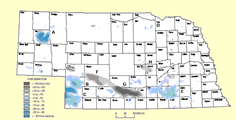Natural Resources, School of

Conservation and Survey Division: Faculty and Staff Publications
ORCID IDs
https://orcid.org/0000-0001-9939-4780
https://orcid.org/0000-0003-3206-4132
https://orcid.org/0000-0002-9601-9464
Document Type
Article
Date of this Version
11-5-2019
Citation
2019 by the authors.
Abstract
Groundwater discharge though streambeds is often focused toward discrete zones, indicating that preliminary reconnaissance may be useful for capturing the full spectrum of groundwater discharge rates using point-scale quantitative methods. However, many direct-contact reconnaissance techniques can be time-consuming, and remote sensing (e.g., thermal infrared) typically does not penetrate the water column to locate submerged seepages. In this study, we tested whether dozens of groundwater discharge measurements made at “uninformed” (i.e., selected without knowledge on high-resolution temperature variations at the streambed) point locations along a reach would yield significantly di erent Darcy-based groundwater discharge rates when compared with “informed” measurements, focused at streambed thermal anomalies that were identified a priori using fiber-optic distributed temperature sensing (FO-DTS). A non-parametric U-test showed a significant difference between median discharge rates for uninformed (0.05 m day 1; n = 30) and informed (0.17 m day 1; n = 20) measurement locations. Mean values followed a similar pattern (0.12 versus 0.27 m day 1), and frequency distributions for uninformed and informed measurements were also significantly different based on a Kolmogorov–Smirnov test. Results suggest that even using a quick “snapshot-in-time” field analysis of FO-DTS data can be useful in streambeds with groundwater discharge rates
Included in
Geology Commons, Geomorphology Commons, Hydrology Commons, Paleontology Commons, Sedimentology Commons, Soil Science Commons, Stratigraphy Commons


Comments
Water 2019, 11, 2312; doi:10.3390/w11112312 www.mdpi.com/journal/water